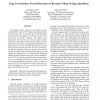Free Online Productivity Tools
i2Speak
i2Symbol
i2OCR
iTex2Img
iWeb2Print
iWeb2Shot
i2Type
iPdf2Split
iPdf2Merge
i2Bopomofo
i2Arabic
i2Style
i2Image
i2PDF
iLatex2Rtf
Sci2ools
116
Voted
MASCOTS
2003
2003
Using User Interface Event Information in Dynamic Voltage Scaling Algorithms
Increasingly, mobile computers use dynamic voltage scaling (DVS) to reduce CPU voltage and speed and thereby increase battery life. To determine how to change voltage and speed when responding to user interface events, we analyze traces of real user workloads. We evaluate a new heuristic for inferring when user interface tasks complete and find it is more efficient and nearly as effective as other approaches. We compare DVS algorithms and find that for a given performance level, the PACE algorithm uses the least energy and the Stepped algorithm uses the second least. We find that different types of user interface event (mouse movements, mouse clicks, and keystrokes) trigger tasks with significantly different CPU use, suggesting one should use different speeds for different event types. We also find differences in CPU use between categories of the same event type, e.g., between pressing spacebar and pressing enter, and between events of different applications. Thus, it is better ...
Related Content
| Added | 31 Oct 2010 |
| Updated | 31 Oct 2010 |
| Type | Conference |
| Year | 2003 |
| Where | MASCOTS |
| Authors | Jacob R. Lorch, Alan Jay Smith |
Comments (0)

